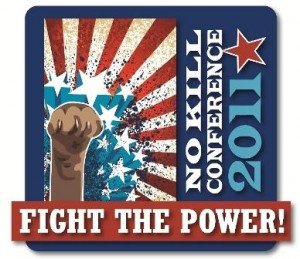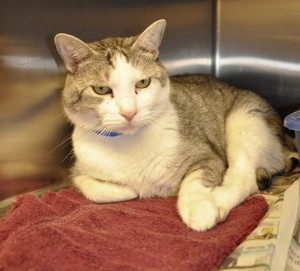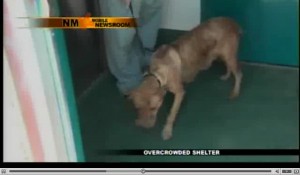What they said: notable quotes from day 2 of No Kill Conference 2011
Day 2 continued the whirlwind begun in day 1 of No Kill Conference 2011. There were many more talks than any one person could possibly–so many more that two people could attend every session and have no overlap in content. Brent Toellner, one of the presenters from yesterday, has a collection of links to blog posts on the conference overall and on particular presentations.
Attorney Kate Neiswender on ‘Legislating No Kill‘:
Politicians have a long memory for the people who help them.
Legislators love numbers.
You will find help in strange places.
An editorial in support of your bill in the local paper is legislative gold.
Diane Blankenberg of Nevada Humane Society on ‘Harnessing Community Compassion’:
“Opportunities multiply as they are seized.” –Sun Tzu
Volunteers are ambassadors in the community. They will tell other people about their experiences.
The average volunteer is with the organization for 90 days. That is a lot of turnover. make it easy and flexible to be a volunteer.
Get rid of patronizing rules. They are unwelcoming.
The focus is on fun. Match people with what they want to do. Challenge them to name a skill that they have that can’t be used by the shelter.
Reach out to the media. Be responsive to them and they will be responsive to you.
Keeping volunteers is a challenge. People need to feel like they are using their talents.
“Enthusiasm is contagious. Start an epidemic.” –Don Ward
Create positive experiences.
Example of a car decal given to volunteers at a recognition event: “I’m a Nevada Humane Society foster parent. I save lives.”
Your program doesn’t have to be perfect. It is a work in progress.
We make it easy for rescue groups–they can have any animal they want at no charge, and we help with spay-neuter. We don’t complain about ‘cherry-picking’–we’re glad to let them have animals.
“The combined force of a thousand sparks makes a powerful bolt of lightning.” –Arlo Guthrie
During lunch Nathan Winograd spoke about leadership:
For so long, the bar has been set so low that we get excited about crumbs, but we deserve more.
What is the most important characteristic of a leader? I would argue that it is imagination.
Directors of kill ‘shelters’ need to ask themselves: “What do you want your legacy to be?”
It is never too late to do the right thing.
Excuses will be proven false.
Imagination = Lifesaving²
Robyn Kippenberger of the RNZSPCA spoke about “Leadership” (do you see a theme here?):
Proverbs 29:18–”Where there is no vision, the people [and animals] perish.”
You need to re-sensitize people, many of them have killed for a long time. You have to come forward and let yourself feel in this work. If you don’t, your heart is not in it, the passion isn’t there.
Imagine that the animal before you is your animal. If you do not, then you are not doing the best for that animal.
Save one life at a time, with the intention of saving them all.
“When placed in command, take charge.” –General Norman Schwarzkopf
With leadership comes responsibility. When you know this stuff [the stuff in Redemption], you can’t un-know it.
We bring joy–and so much more.
“You must do the thing you think you cannot do.” –Eleanor Roosevelt
It’s the “Can do!” that will save lives.
My philosophy is, if we’ve got money in the bank, we should be spending it on saving lives.
“Neuter is cuter.”
Storytelling is part of bringing people into the circle, into the tribe, and people will remember and tell the stories.
“To the world, you may be just one person, but to one life, you may be the world.” –Anonymous
Christie Keith spoke about “Getting Your Paws on More Media”:
Many media figures have pets, but few really understand your issues.
Your best media contacts may be weather guys, sportscasters, movie reviewers, etc. They have pets or their audience does. Their audience is unexploited territory for you!
Think of it as courtship, relationship-building. Don’t ask for something right away. For 20 you reach out to, you will be lucky to get one.
Journalists are used to being reached out to, so get over your shyness and be more professional.
Cute animals are the greatest PR tool ever.
Before you send a press release, put it on your website, or at least as a Facebook note. Journalists must be able to link to you.
Bloggers have more influence than their readership numbers may indicate. When you have a cause, you want to target influencers.
Reporters may have relationships with regressive shelter directors. Never target them or tell them that they are wrong, reach out to them on a human level.
Be professional and brief.
It takes an enormous army of people, of the dogs themselves, an enormous wave, to combat the propaganda against pit bulls that’s out there.
Journalists get frustrated when people want to tell them what the story is, especially if it’s controversial. Your goal is to get attention.
Remember the difference between advertising and news.
Investigative journalists are few and far between. Bloggers are filling this niche.
Is it a story? Does it have a hook? is it interesting?
Set out to be newsworthy (like Bonney Brown).
From the closing remarks by Nathan Winograd:
Lifesaving is the only criteria of success.
The status quo will call you crazy. But No Kill is far from crazy. Every new idea has been called “crazy”.
“‘We’ve always done it this way’ never justifies anything.” –Mitch Schneider
Most resistance to change is laziness.
“Be bold and mighty forces will come to your aid.” –Goethe
No Kill represents nothing short of a paradigm shift in animal sheltering, a completely new, rigorously positive, forward-thinking way, and that is perhaps the hardest part, especially if you have been steeped in the old ways, especially if you have killed animals. The rest is just work.
The public–those people you’ve been led to believe were the enemy, the ones that criticize shelter killing–they’re the key to saving lives. If you stop punishing them and yourself, and ask them for help, sincerely ask them, and if you commit yourself to laying down the needle, you will be amazed at what can happen. There is a groundswell of change in the world of animal sheltering. You can choose to be a part of this lifesaving adventure, or you can fight it bitterly for a time, kill some more animals, make some human lives that much more miserable, and then be swept away. We’re past the point of no return.
Spaying and neutering and humane education are not “the only way”, they put off success until some vague time in the future. They will do nothing to stop the rampant gratuitous killing and abuse in shelters today. That is the task before us. People want to save lives now, and we have a proven model for doing so. Join the growing list of No Kill communities by following the No Kill Equation.
It has worked everywhere that it has been wholeheartedly implemented–Shelby County, Kentucky, Marquette, Michigan, Tompkins County, New York, Austin, Texas, Reno, Nevada, and in communities in Australia and New Zealand. It doesn’t matter if the community is urban or rural, in the desert or in the mountains, on an island or on the mainland, in a politically liberal or conservative area. It doesn’t even matter if you drive on the left side of the road.
It works. No excuses.












